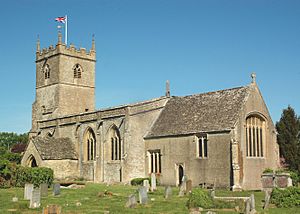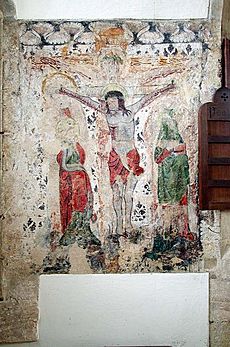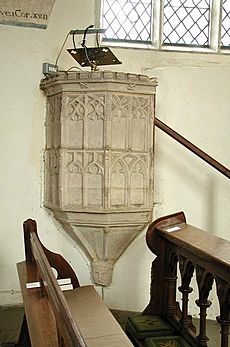St Laurence's Church, Combe Longa facts for kids
Quick facts for kids St Laurence's Church |
|
|---|---|
| Parish Church of St Laurence, Combe Longa | |

St Laurence's from the southeast
|
|
| Location | Church Walk, Combe, Oxfordshire OX29 8NG |
| Country | England |
| Denomination | Church of England |
| History | |
| Dedication | Laurence of Rome |
| Architecture | |
| Heritage designation | Grade I listed |
| Designated | 27 August 1957 |
| Style | Perpendicular Gothic |
| Years built | 12th century, late 14th century |
| Administration | |
| Deanery | Woodstock |
| Archdeaconry | Dorchester |
| Diocese | Oxford |
| Province | Canterbury |
St Laurence's Church in Combe Longa is a special church in Combe, Oxfordshire, England. It's part of the Church of England. This church is also on the path of the Wychwood Way, a long walking trail.
Contents
History of St Laurence's Church
A church has stood in Combe since about 1141. Back then, Empress Matilda gave the church to Eynsham Abbey, which was a home for Benedictine monks.
During the Middle Ages, Oxfordshire was part of the Diocese of Lincoln. In 1478, Thomas Rotherham, who was the Bishop of Lincoln, gave St Laurence's Church to Lincoln College, Oxford. This college still helps support the church today.
Old Parts of the Church Building
Some parts of the church building are very old, dating back to the 12th century. This includes the inner doorway of the north porch. The main part of the church, called the nave, was rebuilt in the late 1300s.
Inside, you can see a stone pulpit from the 14th or 15th century. There are also amazing wall paintings from around 1440. The church still has pieces of stained glass windows from the 15th century. One of the best pieces shows Saint James the Great. In the east window of the chancel, you can see images of Christ in Majesty with Saint Mary, surrounded by angels.
In 1821, a gallery was added to the nave. Box pews, which are like enclosed seating areas, were also put in during the 1820s. However, by 1843, people thought these pews looked "miserable" and the church seemed "dirty."
Restoration Work on the Church

In 1891, a new vicar named Stephen Pearce arrived. He worked hard to improve the church. He started a big restoration project in 1892. During this work, the gallery was removed, and the 15th-century wall paintings were found hidden under layers of paint.
These rediscovered paintings include:
- An Annunciation (when the angel Gabriel told Mary she would have Jesus) on the south wall.
- A crucifixion of Jesus scene near the pulpit.
- Part of a Doom painting (showing the Last Judgment) above the chancel arch.
- A painting of Saint Christopher with fish and an otter on the south wall.
- A painting of Saint Catherine of Alexandria on the north wall.
From 1892 to 1894, the walls and windows of the nave and chancel were fixed. The nave roof was repaired between 1907 and 1909. In 1918, a fire badly damaged the church tower. It was rebuilt in 1922. More repairs happened later, including the tower stonework from 1952 to 1955, the chancel roof in 1963, and the nave roof in 1976.
The 1918 fire destroyed many old church records. Luckily, some records kept in the vicarage survived. These included the parish register from 1646 to 1705, some 19th-century registers, and notes from church meetings. St Laurence's Church is now a Grade I listed building, which means it's a very important historic site.
Bells and Clocks
The first mention of bells at the church was in 1585. By the late 1800s, the church had a "ring" of five bells, meaning five bells that could be rung together. These bells were made in different years: 1602 or 1621, 1628, 1629, 1698, and 1723. James Keene of Woodstock made the bells from 1628 and 1629. The tower also had a very old turret clock, possibly made in the early 1600s.
After the 1918 fire, the damaged bells were recast by John Taylor & Co in 1924 or 1925. They became a ring of six bells. The church also has a smaller Sanctus bell.

The 1918 fire turned the historic clock into "a twisted mass of old iron." In the late 1930s, these remains were given to the Museum of the History of Science, Oxford. There, experts fixed it up and put it on display. Donald Harden, a museum expert, noticed it looked like the Dover Castle Clock. In 1938, he decided both clocks were made by the same person. The Combe clock originally had a simple verge escapement mechanism, but it was later updated in the 1600s with a short pendulum.
A new clock for the church was provided by John Smith and Sons of Derby in 1948.

